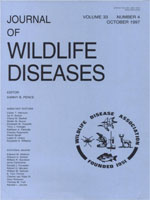Diagnostic findings are presented for 434 common loons (Gavia immer) found sick or dead on Florida beaches from 1970 through 1994, primarily during the months of December to April. The most commonly recognized problem was an emaciation syndrome (66%), followed by oiling (18%), aspergillosis (7%), trauma (5%) and miscellaneous disease entities (1%). The cause-of-death for 3% of the birds was not determined. Many of the carcasses examined (n = 173) were obtained during an epizootic which occurred from January to March of 1983 in which more than 13,000 loons were estimated to have died. An emaciation syndrome, characterized by severe atrophy of pectoral muscles, loss of body fat and hemorrhagic enteritis, was the primary finding in this epizootic. It was postulated to have a complex etiologic basis involving synergistic effects and energy costs of migration, molting and replacement of flight feathers, food resource changes, salt-loading, intestinal parasitism, environmental contaminants, and inclement weather.
How to translate text using browser tools
1 October 1997
WINTER MORTALITY OF COMMON LOONS IN FLORIDA COASTAL WATERS
Donald J. Forrester,
William R. Davidson,
Robert E. Lange Jr.,
Richard K. Stroud,
Lawrence L. Alexander,
J. Christian Franson,
Susan D. Haseltine,
Ramon C. Littell,
Stephen A. Nesbitt

Journal of Wildlife Diseases
Vol. 33 • No. 4
October 1997
Vol. 33 • No. 4
October 1997
aspergillosis
common loons
emaciation
environmental contaminants
Gavia immer
Oil spills
parasites




